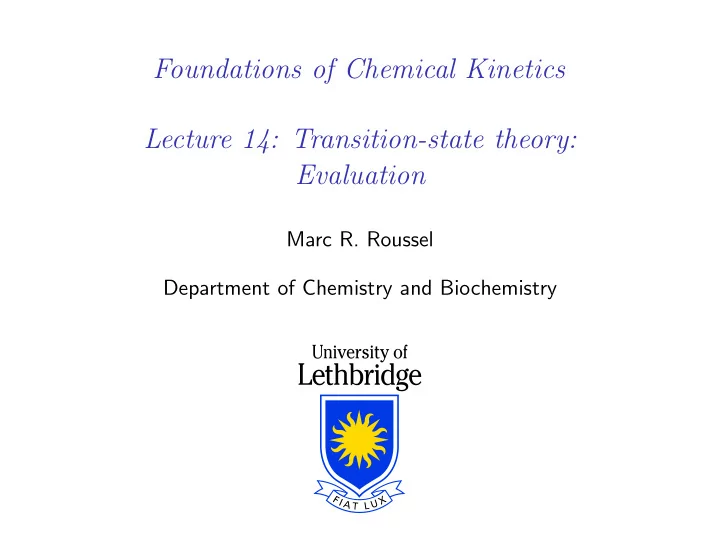

Foundations of Chemical Kinetics Lecture 14: Transition-state theory: Evaluation Marc R. Roussel Department of Chemistry and Biochemistry
What works ◮ The thermodynamic formalism of transition-state theory connects well to other parts of physical chemistry, making the theory conceptually useful. ◮ For very simple reactions, transition-state theory often gives fairly good values. ◮ Even when the theory doesn’t do a great job of predicting the value of a rate constant, it often predicts the relative effect of various factors on the rate constant correctly, e.g. isotope effects. ◮ It’s an important starting point for understanding reactions under non-ideal conditions, e.g. the effect of ionic strength.
What doesn’t work ◮ Transition-state theory often badly overestimates rate constants. This is thought to result from trajectories that cross the saddle point and then turn around and come back, which are not properly accounted for in the theory. This is sometimes fixed by multiplying transition-state rate constants by a transmission coefficient ( κ ), which is unfortunately not much more than a fudge factor. Q ‡ � − ∆ E 0 � k = κ k B T N exp c ◦ h Q X Q Y RT
What doesn’t work (continued) ◮ One part of transition-state theory, the idea of passage through the transition state from reactants to products, is an irreducibly classical mechanical idea. Of course, molecules are quantum mechanical objects, so the idea of a trajectory through the transition state can’t be right. This leads to a number of difficulties which have not, to this day, been resolved. ◮ What exactly do we mean by passage through the transition state? ◮ Tunneling is important in reactions involving motions of light particles (electron-transfer reactions, proton-transfer reactions, etc.). ◮ Separability of the reaction coordinate is not guaranteed.
What doesn’t work (continued) ◮ The equilibrium approximation at the heart of transition-state theory is only valid for high barriers. ◮ In most reactions, the reactants have to be in a fairly specific quantum state to react (e.g. one specific vibrational mode has to have enough energy, and the energy in the other modes doesn’t matter). This will tend to have the effect of creating a non-equilibrium (i.e. non-Boltzmann) distribution of energy. If this effect is sufficiently strong, perhaps because molecules energized in the correct vibrational mode react very quickly, then again the equilibrium approximation might not be valid, regardless of the height of the barrier. In either of the above cases, transition-state theory might give results that are not even qualitatively correct.
Recommend
More recommend